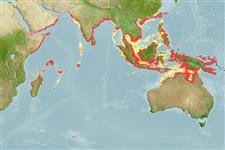>
Clupeiformes (Herrings) >
Dorosomatidae (Gizzard shads and sardinellas)
Etymology: Hilsa: Bangladesh and Bengali local name for a fish.
More on author: Cuvier.
Environment: milieu / climate zone / depth range / distribution range
Sinh thái học
Biển; Nước ngọt; Thuộc về nước lợ; di cư biển sông (để đẻ trứng) (Ref. 51243); Mức độ sâu 10 - ? m (Ref. 30573). Tropical; 25°N - 18°S, 43°E - 155°E (Ref. 54554)
Indo-West Pacific: probably all coasts of Indian Ocean, from Gulf of Oman and Gulf of Aden south to Durban and Madagascar, across the Bay of Bengal, Gulf of Thailand, Java Sea and north to Hong Kong and east to Papua New Guinea and possibly further (Ref. 188).
Length at first maturity / Bộ gần gũi / Khối lượng (Trọng lượng) / Age
Maturity: Lm 15.0 range ? - ? cm
Max length : 35.0 cm TL con đực/không giới tính; (Ref. 11228); common length : 16.5 cm SL con đực/không giới tính; (Ref. 188)
Các tia vây lưng cứng (tổng cộng) : 0; Các vây lưng mềm (tổng cộng) : 16 - 19; Tia cứng vây hậu môn: 0; Tia mềm vây hậu môn: 17 - 23. Diagnosis: Body fairly deep and compressed, belly with distinct keel of scutes; top of head with numerous fronto-parietal striae; upper jaw with median notch; gillrakers about 100 to 175, those on inner arches distinctly curled; outer row of gill filaments on first arch not more than half length of gillrakers; a series of small triangular scales above axil of pectoral fin; hind part of body scales perforated (Ref. 188). A black spot behind gill cover, usually followed by up to 10 spots along flank (Ref. 188).
Found in coastal waters (Ref. 3107, 30573); marine, pelagic, but entering estuaries and able to tolerate quite low salinities (7 ppt) (Ref. 188). Feeds chiefly on phytoplankton, mainly diatoms, also dinoflagellates, but also copepods, molluscan and crustacean larvae, prawns, amphipods and polychaetes (Ref. 188). Spawns, at least in Godavari estuary, around February (Ref. 188). Marketed fresh, dried, dried-salted and boiled. Made into fish balls.
Whitehead, P.J.P., 1985. FAO Species Catalogue. Vol. 7. Clupeoid fishes of the world (suborder Clupeoidei). An annotated and illustrated catalogue of the herrings, sardines, pilchards, sprats, shads, anchovies and wolf-herrings. FAO Fish. Synop. 125(7/1):1-303. Rome: FAO. (Ref. 188)
IUCN Red List Status (Ref. 130435: Version 2024-2)
Threat to humans
Harmless
Human uses
Các nghề cá: tính thương mại cao; mồi: occasionally
Các công cụ
Special reports
Download XML
Các nguồn internet
Estimates based on models
Preferred temperature (Ref.
123201): 25.8 - 29.1, mean 28.3 °C (based on 772 cells).
Phylogenetic diversity index (Ref.
82804): PD
50 = 1.0000 [Uniqueness, from 0.5 = low to 2.0 = high].
Bayesian length-weight: a=0.01023 (0.00643 - 0.01629), b=3.03 (2.90 - 3.16), in cm total length, based on LWR estimates for this species & (Sub)family-body (Ref.
93245).
Mức dinh dưỡng (Ref.
69278): 2.9 ±0.33 se; based on food items.
Generation time: 1.0 ( na - na) years. Estimated as median ln(3)/K based on 1
growth studies.
Thích nghi nhanh (Ref.
120179): Chiêù cao, thời gian nhân đôi của chủng quần tối thiểu là dưới 15 tháng (K=1.1).
Fishing Vulnerability (Ref.
59153): Low vulnerability (18 of 100).
Climate Vulnerability (Ref.
125649): High to very high vulnerability (71 of 100).
Nutrients (Ref.
124155): Calcium = 204 [116, 375] mg/100g; Iron = 2.01 [1.12, 3.29] mg/100g; Protein = 19.2 [18.1, 20.2] %; Omega3 = 0.411 [0.231, 0.728] g/100g; Selenium = 61.5 [30.1, 125.8] μg/100g; VitaminA = 9.95 [4.03, 23.19] μg/100g; Zinc = 1.78 [1.25, 2.60] mg/100g (wet weight);
